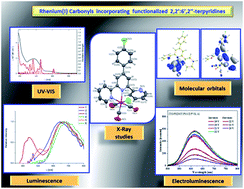Synthesis, photophysical properties and application in organic light emitting devices of rhenium(i) carbonyls incorporating functionalized 2,2′:6′,2′′-terpyridines†
Abstract
Several new rhenium(I) complexes [ReCl(CO)3(4′-R-terpy-κ2N)] incorporating 2,2′:6′,2′′-terpyridine-based ligands were successfully synthetized and characterized by IR, NMR (1H and 13C), UV-vis spectroscopy and single crystal X-ray analysis. The luminescent properties of [ReCl(CO)3(4′-R-terpy-κ2N)] were studied in solution and solid state, at 298 and 77 K. To better understand the photophysical properties of [ReCl(CO)3(4′-R-terpy-κ2N)], density functional theory (DFT) and time-dependent DFT (TD-DFT) calculations were performed. Preliminary studies towards application of these complexes in organic light emitting diodes (OLEDs) were carried out, including testing the possibility of electroluminescence intensity increase by including metallic nanowires in the structure design.


 Please wait while we load your content...
Please wait while we load your content...